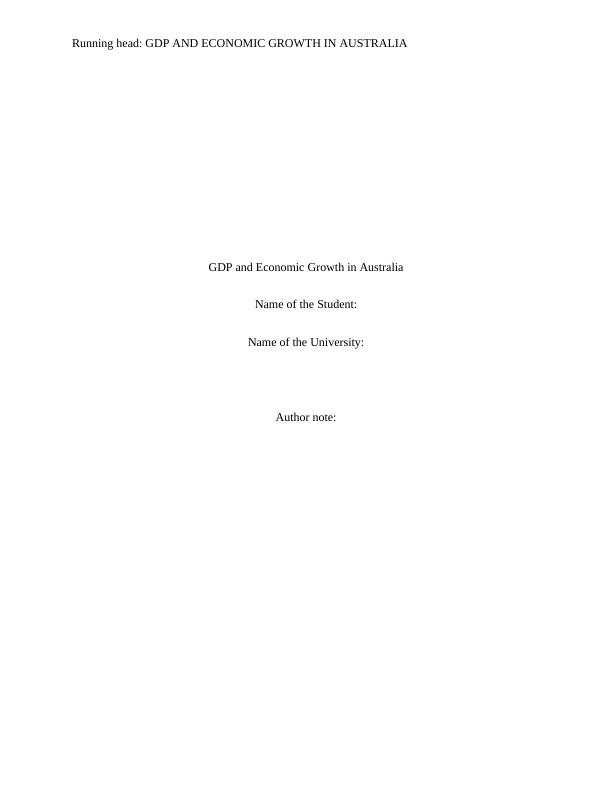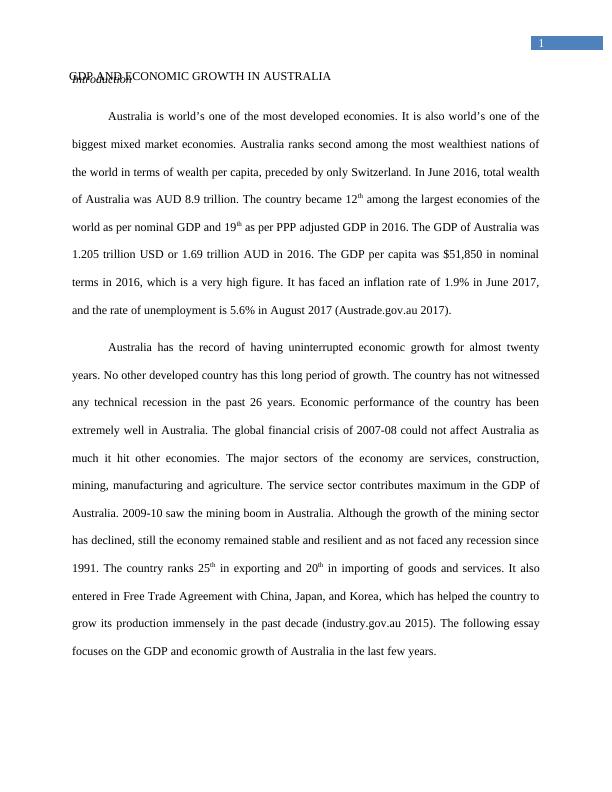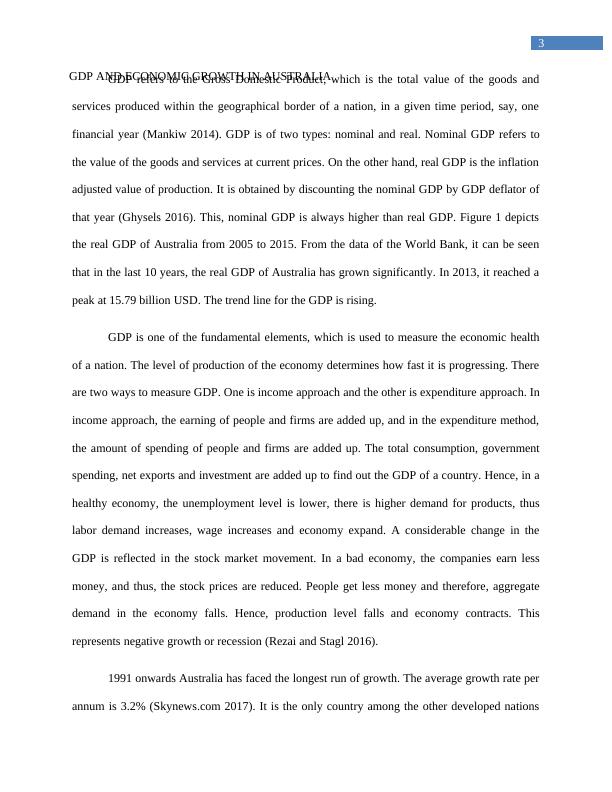Report on GDP and Economic Growth in Australia
15 Pages3182 Words80 Views
Added on 2020-04-07
Report on GDP and Economic Growth in Australia
Added on 2020-04-07
ShareRelated Documents
Running head: GDP AND ECONOMIC GROWTH IN AUSTRALIA GDP and Economic Growth in Australia Name of the Student:Name of the University:Author note:

1GDP AND ECONOMIC GROWTH IN AUSTRALIAIntroductionAustralia is world’s one of the most developed economies. It is also world’s one of thebiggest mixed market economies. Australia ranks second among the most wealthiest nations ofthe world in terms of wealth per capita, preceded by only Switzerland. In June 2016, total wealthof Australia was AUD 8.9 trillion. The country became 12th among the largest economies of theworld as per nominal GDP and 19th as per PPP adjusted GDP in 2016. The GDP of Australia was1.205 trillion USD or 1.69 trillion AUD in 2016. The GDP per capita was $51,850 in nominalterms in 2016, which is a very high figure. It has faced an inflation rate of 1.9% in June 2017,and the rate of unemployment is 5.6% in August 2017 (Austrade.gov.au 2017). Australia has the record of having uninterrupted economic growth for almost twentyyears. No other developed country has this long period of growth. The country has not witnessedany technical recession in the past 26 years. Economic performance of the country has beenextremely well in Australia. The global financial crisis of 2007-08 could not affect Australia asmuch it hit other economies. The major sectors of the economy are services, construction,mining, manufacturing and agriculture. The service sector contributes maximum in the GDP ofAustralia. 2009-10 saw the mining boom in Australia. Although the growth of the mining sectorhas declined, still the economy remained stable and resilient and as not faced any recession since1991. The country ranks 25th in exporting and 20th in importing of goods and services. It alsoentered in Free Trade Agreement with China, Japan, and Korea, which has helped the country togrow its production immensely in the past decade (industry.gov.au 2015). The following essayfocuses on the GDP and economic growth of Australia in the last few years.

2GDP AND ECONOMIC GROWTH IN AUSTRALIAEconomic performances of AustraliaIt has been a great achievement for Australians that a generation of the country has notexperienced recession while growing up. There is huge prosperity in the country. Level ofunemployment has been low and stable and inflation rate has been low in the past few decades.The country is rich in natural resources. Hence, the mining sector was developed tremendously.The mining sector has generated the maximum employment in the country. However, the non-resource sectors started to develop in the 2000s and the focus has shifted to these sectors.Globalization and economic liberalization have contributed to make the economy open(Battellino 2013).200520062007200820092010201120122013201420150.002.004.006.008.0010.0012.0014.0016.0018.009.249.4710.3112.1910.2112.4514.2715.4715.7914.4913.45Real GDP of Australia, 2005-2015AUS Real GDP (Current US $, Billion)Linear (AUS Real GDP (Current US $, Billion))Figure 1: Real GDP of Australia, 2005-2015(Source: World Bank 2017)

3GDP AND ECONOMIC GROWTH IN AUSTRALIAGDP refers to the Gross Domestic Product, which is the total value of the goods andservices produced within the geographical border of a nation, in a given time period, say, onefinancial year (Mankiw 2014). GDP is of two types: nominal and real. Nominal GDP refers tothe value of the goods and services at current prices. On the other hand, real GDP is the inflationadjusted value of production. It is obtained by discounting the nominal GDP by GDP deflator ofthat year (Ghysels 2016). This, nominal GDP is always higher than real GDP. Figure 1 depictsthe real GDP of Australia from 2005 to 2015. From the data of the World Bank, it can be seenthat in the last 10 years, the real GDP of Australia has grown significantly. In 2013, it reached apeak at 15.79 billion USD. The trend line for the GDP is rising. GDP is one of the fundamental elements, which is used to measure the economic healthof a nation. The level of production of the economy determines how fast it is progressing. Thereare two ways to measure GDP. One is income approach and the other is expenditure approach. Inincome approach, the earning of people and firms are added up, and in the expenditure method,the amount of spending of people and firms are added up. The total consumption, governmentspending, net exports and investment are added up to find out the GDP of a country. Hence, in ahealthy economy, the unemployment level is lower, there is higher demand for products, thuslabor demand increases, wage increases and economy expand. A considerable change in theGDP is reflected in the stock market movement. In a bad economy, the companies earn lessmoney, and thus, the stock prices are reduced. People get less money and therefore, aggregatedemand in the economy falls. Hence, production level falls and economy contracts. Thisrepresents negative growth or recession (Rezai and Stagl 2016). 1991 onwards Australia has faced the longest run of growth. The average growth rate perannum is 3.2% (Skynews.com 2017). It is the only country among the other developed nations

End of preview
Want to access all the pages? Upload your documents or become a member.
Related Documents
The Economy of Australia - ECCON 101 - Economicslg...
|15
|2918
|63
Analysis of economic growth of Australia in the last 3 to 5 yearslg...
|19
|3601
|449
Analysis of Australia's Economic Performance from 2008 to 2018lg...
|14
|2836
|314
Growth Rates of the Australian Economy Over the Last Ten Yearslg...
|13
|2800
|374
Analysis of Australia’s Macroeconomic Factors: Production Output Performance, Unemployment, Inflation and Pricelg...
|14
|3213
|250
Economic Principles and Decision Makinglg...
|15
|4425
|71
